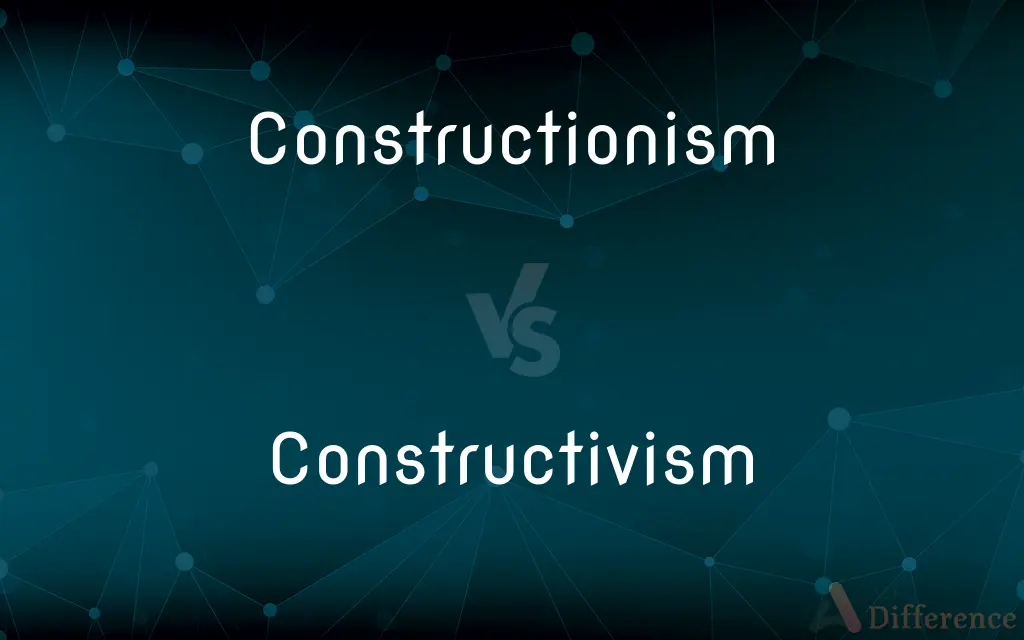Constructionism vs. Constructivism — What's the Difference?
By Tayyaba Rehman & Maham Liaqat — Updated on April 15, 2024
Constructionism focuses on learning through creating physical objects, emphasizing hands-on experience, while Constructivism centers on constructing knowledge through experiences and reflection.

Difference Between Constructionism and Constructivism
Table of Contents
ADVERTISEMENT
Key Differences
Constructionism promotes active involvement in creating tangible artifacts as a primary way to learn, believing that this physical engagement enhances understanding. In contrast, Constructivism argues that learning occurs through mental construction, where learners actively create meaning from their experiences rather than passively receiving information.
In the realm of education, Constructionism might be implemented in classrooms through activities like robotics or model building, where the physical act of creation is crucial. Whereas Constructivism often involves thought experiments, discussions, and reflection, focusing more on the cognitive processes behind learning.
Constructionism often uses tools and materials to facilitate learning, suggesting that the tangible outputs create a context for reflecting on the learning process. On the other hand, Constructivism might use tools like concept maps or collaborative discussions to help learners visualize and articulate their thought processes.
Supporters of Constructionism believe that making something external and shareable, like a project or a model, provides a powerful stimulus for internal reflection and consolidation of knowledge. Conversely, Constructivists emphasize that learning can occur internally and can be invisible, focusing on the learner's ability to integrate new information with existing knowledge.
The pedagogical strategies of Constructionism typically require physical resources and spaces where learners can manipulate and build. In contrast, Constructivist strategies can be more flexible, occurring in traditional classrooms or virtual environments, where the focus is on the interaction and the flow of ideas.
ADVERTISEMENT
Comparison Chart
Focus
Creating physical objects
Constructing mental schemas
Educational Tools
Physical tools (e.g., building kits)
Cognitive tools (e.g., mind maps)
Learning Environment
Requires physical space for creation
Flexible, any setting can work
Visibility of Learning
Learning is visible through objects
Learning is often internal
Pedagogical Approach
Hands-on, project-based
Discussion-based, reflective
Compare with Definitions
Constructionism
Learning through building and making.
Students learn physics principles better when they construct working models.
Constructivism
Learning as an active, constructive process.
In constructivist classrooms, students create hypotheses based on their observations.
Constructionism
Emphasizes physical engagement.
In a constructionist classroom, children might build circuits to understand electricity.
Constructivism
Focuses on the learner's perspective and background.
Constructivist teaching methods adapt to include the diverse cultural backgrounds of students.
Constructionism
Advocates for tangible, shareable products as learning outcomes.
The final project in a constructionism-based course might be a publicly displayed robot.
Constructivism
Emphasizes mental and cognitive processes.
Constructivism integrates critical thinking into learning by encouraging reflection on experiences.
Constructionism
Fosters creativity and innovation through hands-on activity.
Constructionism encourages innovative solutions by having students design their own experiments.
Constructivism
Encourages dialogue and interaction to facilitate learning.
Constructivist teachers often use Socratic questioning to guide students to deeper understanding.
Constructionism
Supports collaborative learning through group projects.
Students collaborate to build a scale model of a sustainable city.
Constructivism
Adaptable to individual learning styles.
Constructivism tailors activities to suit auditory, visual, and kinesthetic learners.
Constructionism
(legal) A strict interpretation of the actual words and phrases used in law, rather than any underlying intent.
Constructivism
A style or movement in which assorted mechanical objects are combined into abstract mobile structural forms. The movement originated in Russia in the 1920s and has influenced many aspects of modern architecture and design.
Constructionism
(social science) The idea that people learn about, or perceive the world by constructing mental models.
Constructivism
A view which admits as valid only constructive proofs and entities demonstrable by them, implying that the latter have no independent existence.
Constructivism
A movement in modern art originating in Moscow in 1920 and characterized by the use of industrial materials such as glass, sheet metal, and plastic to create nonrepresentational, often geometric objects.
Constructivism
(arts) A Russian movement in modern art characterized by the creation of nonrepresentational geometric objects using industrial materials.
Constructivism
(mathematics) A philosophy that asserts the need to construct a mathematical object to prove it exists.
Constructivism
A psychological epistemology which argues that humans generate knowledge and meaning from their experiences.
Constructivism
An abstractionist artistic movement in Russia after World War I; industrial materials were used to construct nonrepresentational objects
Common Curiosities
What types of activities are typical in Constructivist classrooms?
Activities include problem-solving tasks, discussions, and projects that require students to apply concepts and reflect on their learning.
How does Constructivism define learning?
Constructivism views learning as the process of mentally constructing knowledge through personal experiences and reflections.
What is the main focus of Constructionism?
Constructionism focuses on learning through the process of making and creating tangible objects.
How does the learning visibility differ between the two theories?
In Constructionism, learning is often visible through physical projects, while in Constructivism, learning is more internal and may not be immediately observable.
How do Constructivist approaches handle varying student backgrounds?
Constructivist methods highly value and incorporate students' backgrounds and prior knowledge into the learning process.
What is the role of the teacher in Constructivist learning?
Teachers in Constructivist settings act more as coaches or facilitators, guiding students through the learning process rather than directly instructing.
What is the role of the teacher in Constructionist learning?
Teachers act as facilitators and guides, helping to set up the environment and resources needed for creation.
What challenges might a teacher face when implementing Constructionism?
Challenges include the need for adequate space, materials, and potentially higher costs associated with physical projects.
What are the cognitive benefits of Constructivism?
Benefits include enhanced critical thinking, better problem-solving skills, and a deeper understanding of content through active engagement and reflection.
Can Constructionism be applied in digital environments?
Yes, although it emphasizes physical creation, digital tools like simulation software can also facilitate constructionist learning.
How do these theories apply to adult education?
Both theories can be highly effective in adult education, with Constructionism providing practical skills through hands-on activities and Constructivism enhancing professional skills like critical thinking and problem-solving.
Is Constructionism suitable for all subjects?
While particularly effective in science, technology, engineering, and mathematics (STEM), it can be adapted to other subjects through creative project-based learning.
Can technology enhance Constructionist learning?
Yes, technologies like 3D printers and virtual reality can enhance constructionist approaches by allowing students to create complex, multidimensional projects.
What impact do these educational theories have on learning outcomes?
Both theories can improve learning outcomes by making education more engaging and closely aligned with how individuals naturally learn.
How does Constructivism impact student motivation?
It often increases motivation by making learning more relevant and tailored to the interests and experiences of the learners.
Share Your Discovery

Previous Comparison
Malt vs. Maltose
Next Comparison
Threatening vs. BlackmailAuthor Spotlight
Written by
Tayyaba RehmanTayyaba Rehman is a distinguished writer, currently serving as a primary contributor to askdifference.com. As a researcher in semantics and etymology, Tayyaba's passion for the complexity of languages and their distinctions has found a perfect home on the platform. Tayyaba delves into the intricacies of language, distinguishing between commonly confused words and phrases, thereby providing clarity for readers worldwide.
Co-written by
Maham Liaqat















































